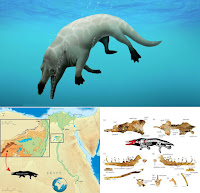 |
| Phiomicetus anubis Gohar, Antar, Boessenecker, Sabry, El-Sayed, Seiffert, Zalmout & Sallam, 2021 |
Abstract
Over about 10 million years, the ancestors of whales transformed from herbivorous, deer-like, terrestrial mammals into carnivorous and fully aquatic cetaceans. Protocetids are Eocene whales that represent a unique semiaquatic stage in that dramatic evolutionary transformation. Here, we report on a new medium-sized protocetid, Phiomicetus anubis gen. et sp. nov., consisting of a partial skeleton from the middle Eocene (Lutetian) of the Fayum Depression in Egypt. The new species differs from other protocetids in having large, elongated temporal fossae, anteriorly placed pterygoids, elongated parietals, an unfused mandibular symphysis that terminates at the level of P3, and a relatively enlarged I3. Unique features of the skull and mandible suggest a capacity for more efficient oral mechanical processing than the typical protocetid condition, thereby allowing for a strong raptorial feeding style. Phylogenetic analysis nests Phiomicetus within the paraphyletic Protocetidae, as the most basal protocetid known from Africa. Recovery of Phiomicetus from the same bed that yielded the remingtonocetid Rayanistes afer provides the first clear evidence for the co-occurrence of the basal cetacean families Remingtonocetidae and Protocetidae in Africa. The discovery of Phiomicetus further augments our understanding of the biogeography and feeding ecology of early whales.
Keywords: biogeography, whales, phylogeny, evolution, Fayum
Abdullah S. Gohar, Mohammed S. Antar, Robert W. Boessenecker, Dalia A. Sabry, Sanaa El-Sayed, Erik R. Seiffert, Iyad S. Zalmout and Hesham M. Sallam. 2021. A New Protocetid Whale offers clues to Biogeography and Feeding Ecology in early Cetacean Evolution. Proc. R. Soc. B.. 288. 20211368. DOI: 10.1098/rspb.2021.1368








